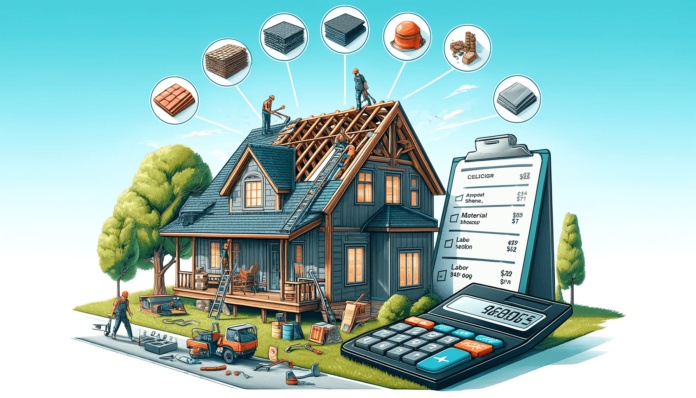Introduction
- Roof Replacement Cost: Essential Insights for Homeowners
- Why Roof Replacement is Important
- Key Elements Influencing the Cost of Roof Replacement
- How Roof Size Influences the Overall Cost of Replacement
- Types of Roofing Materials and Their Costs
- Labor Costs for Roof Replacement
- Location and Its Influence on Roofing Costs
- Additional Costs to Consider in a Roof Replacement
- DIY vs. Hiring a Professional: Cost Implications
- Budgeting for a Roof Replacement
- Financing Options for Roof Replacement
- Insurance and Roof Replacement Costs
- Conclusion
Understanding roof replacement costs is essential when planning for a home renovation project. This roofing cost guide aims to break down the various expenses associated with replacing your roof, from materials to labor and additional fees. Knowing what to expect can help you budget effectively and avoid any unexpected surprises during the process.
Roof Replacement Cost: Essential Insights for Homeowners

Understanding the roof replacement cost is crucial for homeowners planning to upgrade or repair their roofing system. The total cost of a roof replacement can vary greatly based on factors like the size of the roof, the materials chosen, labor charges, and the complexity of the job. Typically, the cost can range from a few thousand dollars for a basic asphalt shingle roof to tens of thousands for high-end materials like slate or tile. Knowing these variables helps homeowners budget more effectively and ensures that there are no surprises during the roofing project.
Why Roof Replacement is Important
A properly maintained roof is essential for shielding your home from harsh weather and external elements. Over time, even the most durable roofing materials can wear out, leading to leaks, drafts, and other issues. If you notice missing shingles, water damage, or sagging areas, it might be time to consider a roof replacement. Replacing your roof not only enhances your home’s safety but also increases its resale value.
Key Elements Influencing the Cost of Roof Replacement
The price of a roof replacement can fluctuate significantly based on various factors. Knowing these aspects can help you plan and budget for the costs more effectively. Some of the key elements that influence the price include roof size, materials, labor, location, and any additional repairs required. Knowing how each factor impacts your total bill can help you make informed decisions when planning your budget.
How Roof Size Influences the Overall Cost of Replacement
One of the most significant factors in determining the cost of roof replacement is the size of your roof. Roofers typically charge based on the square footage of the roof, with larger roofs requiring more materials and labor, thus increasing the overall cost. As a rule of thumb, expect to pay more if you have a larger home or complex roof design.
Types of Roofing Materials and Their Costs
The choice of roofing material greatly affects the total replacement cost. Popular materials include asphalt shingles, metal roofing, clay tiles, and slate. Asphalt shingles tend to be the most budget-friendly choice, typically costing between $100 and $200 per square foot. Metal roofs, while more expensive initially, offer durability and energy efficiency. Clay and slate tiles are premium options that provide a unique aesthetic but come with higher price tags. When selecting materials, consider the balance between upfront costs and long-term durability.
Labor Costs for Roof Replacement
Labor costs play a significant role in the overall expense of a roof replacement. Rates can vary depending on the contractor’s experience and your region. In regions where the cost of living is higher, labor expenses for roof replacement are typically increased Labor costs also depend on the complexity of the job; for example, roofs with multiple layers or steep slopes can be more challenging to replace, increasing labor expenses.
Location and Its Influence on Roofing Costs
Where you live can significantly impact the cost of roof replacement. Regional climate, local building codes, and availability of materials all play a role in determining prices. In areas prone to extreme weather, like hurricanes or heavy snowfall, the cost of more durable materials may be higher. Additionally, some states or cities require specific permits for roof replacement, adding to the overall expense.
Additional Costs to Consider in a Roof Replacement
Beyond the basics, several additional costs can impact your roof replacement budget. These include fees for permits, inspections, and the disposal of old roofing materials. It’s also possible to encounter hidden expenses, such as repairs to the roof deck or structural issues that only become apparent once the old roof is removed. Factoring these potential costs into your budget can help you avoid surprises.
DIY vs. Hiring a Professional: Cost Implications
Some homeowners consider a DIY approach to save on labor costs, but this can come with risks. While DIY might seem cheaper initially, mistakes can lead to costly repairs down the line. Professional roofers have the experience and equipment to ensure the job is done right the first time. In many cases, the peace of mind and warranty offered by professional services are worth the additional expense.
Budgeting for a Roof Replacement
Creating a realistic budget for a roof replacement involves more than just calculating the cost of materials and labor. Set aside an additional 10-15% of your estimated cost to cover unexpected expenses. Consider your long-term goals, such as energy efficiency or using premium materials, and adjust your budget accordingly. By planning ahead, you can avoid the stress of unexpected financial strain during the project.
Financing Options for Roof Replacement
If you don’t have the full amount saved for a roof replacement, several financing options can help. Home improvement loans, personal loans, and financing plans offered by roofing contractors are common options. Some homeowners may also consider using a home equity line of credit (HELOC). It’s essential to compare interest rates and terms to find the financing option that best fits your budget.
Insurance and Roof Replacement Costs
In some cases, homeowners insurance may cover part of the roof replacement costs, especially if the damage is caused by natural events like storms. However, insurance policies vary, and it’s crucial to understand what is covered under your plan. Contact your insurance provider to see if you can file a claim for roof damage and how your deductible will affect your out-of-pocket costs.
Conclusion
Replacing your roof is a significant financial commitment, but with careful planning and budgeting, it can be a manageable expense. By understanding the factors that affect the cost of roof replacement and exploring your options, you can make informed decisions that ensure a successful project. Planning ahead will not only protect your home but also provide peace of mind.














